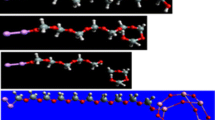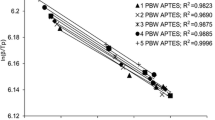Abstract
Nanocomposite of methylsilicone resin/Fe2O3 (MSR/Fe2O3, metal oxide nanoparticles with average particle-size of 20 nm) was successfully synthesized by acid-catalyzed hydrolysis and condensation of methyltrimethoxy silane (MTMS). The obtained nanocomposite was characterized by Fourier-transformed infrared (FT-IR) and X-ray photoelectron spectroscopy (XPS). The FTIR and XPS results show that the nanoparticles were well dispersed in the MSR matrix. The thermogravimetric analysis (TGA) results show that Fe2O3 nanoparticles can remarkably improve the thermal stability of MSR. In comparison with methylsilicone resin, the temperature values of the resulting nanocomposite at the onset of degradation and the maximum rate of mass loss were increased 55 and 76 °C, respectively.
Similar content being viewed by others
Explore related subjects
Discover the latest articles, news and stories from top researchers in related subjects.Avoid common mistakes on your manuscript.
Introduction
The unusually high thermal and thermo-oxidative stability of silicone is one of the important properties. As a member of this family, methylsilicone resins (MSR) have been extensively used in high temperature applications owing to their excellent thermal stability and resistance to thermal oxidative degradation [1]. Whereas the methyl side groups attached to the silicon atoms of methylsilicone resin are inclined to thermal oxidative degradation [2, 3]. Therefore, methylsilicone resin cannot be applied at very high temperature in the atmospheric environment, and it will become brittle when the temperature is beyond its toleration.
Consequently, many groups have focused their attention on the stability research of methylsilicone resin against thermal oxidative degradation [4–6]. With advancements in nanoscience and nanotechnology, many unique properties related to nanoscale have been presented. Acting as thermal stabilizers, metal oxides were found to have promising influence on the resistance to thermal oxidative degradation [7–11]. Here, we report the synthesis of methylsilicone resin/Fe2O3 nanocomposite by acid-catalyzed hydrolysis and condensation of methyltrimethoxy silane, and the thermal stability and degradation behavior of the resulting nanocomposite are investigated.
Experimental
Materials
Methyltrimethoxy silane (MTMS) was supplied by Tianjin Fuchen Chemical Co., Ltd, China. Nanosized iron oxide (Fe2O3) (α phase, mean particle size of 20 nm) was purchased from Shanghai Kaili Ferric Oxide Co., Ltd, China.
Synthesis of hydroxyl-terminated methylsilicone resin (MSR)
Hydroxyl-terminated methylsilicone resin (MSR) was synthesized by acid-catalyzed hydrolysis and condensation of MTMS. In a typical route, 1.0 mol MTMS, 12 g ethanol, small quantity of distilled water, and appropriate amount of hydrochloride acid were added into a four-necked flask equipped with a stirrer, a nitrogen inlet and a thermometer. The molar ratio of HCl/MTMS equals to 0.1. The mixture was stirred for 30 min at room temperature, and then heated at 78–80 °C for 4–6 h under stirring and regulated nitrogen flow. Subsequently, hydrochloride acid was neutralized and the solvent was removed at elevated temperature. Finally, when the reaction temperature reached 140 °C, the transparent methylsilicone resin was obtained.
Synthesis of MSR/Fe2O3 nanocomposite
The resulting hydroxyl-terminated methylsilicone resin and a given amount of nanometric Fe2O3 were blended and stirred vigorously to ensure that the nanoparticles could be evenly dispersed. The mean dispersion of the nanoparticles was 5 wt.%. Then the obtained mixture was poured into Teflon molds and put into an oven to thermal cure at 100, 130, 160 and 180 °C for 12 h. After curing, the MSR/Fe2O3 nanocomposite could be obtained.
Instrumentation
Fourier-transformed infrared (FT-IR) spectra were measured with a spectral resolution of 1 cm−1 on a Nicolet FT-IR spectrophotometer (Nexus670, made in the USA) using KBr pellets at room temperature.
Thermogravimetric analysis (TGA) was performed on a NETZSCH thermoanalyzer (STA449C, made in Germany). Samples weighing about 10.0 mg were heated from 30 to 1200 °C at a heating rate of 10 °C/min in a dynamic air atmosphere.
X-ray photoelectron spectroscopy (XPS) analysis of the samples was carried out in an VG electron spectrometer (ESCALAB Mk II, made in UK) at base pressures in the preparation and analysis chambers of 2 × 10−8 and 1 × 10−8 Pa. The photoelectrons were excited by an X-ray source using Mg Kα (h = 1256.6 eV). The instrumental resolution measured as the full-width at half-maximum of the Ag 3d5/2 photoelectron peak was 1.2 eV for a pass energy in the analyser of 20 eV. The C1s and Si2p photoelectron peaks were recorded.
Results and discussion
The whole process of acid-catalyzed hydrolysis and condensation of methyltrimethoxy silane was formularized as follows:

Fourier-transformed infrared (FT-IR) spectra analysis
Figure 1 shows the Fourier-transformed infrared (FT-IR) spectra of methylsilicone resin (a, c) and methylsilicone resin/Fe2O3 (b, d) nanocomposite calcined at room temperature (RT) and 500 °C, respectively. From Fig. 1a, b, we observe that the characteristic stretch vibration absorption peaks of MSR/Fe2O3 nanocomposite at room temperature are similar to that of MSR at 3,530–3,410 cm−1 (Si–OH), 2,969 cm−1 (C–H in CH3–Si), 1,260 and 760 cm−1 (Si–CH3), and 1,130–1,000 cm−1 (Si–O–Si). After calcination at 500 °C, the Si–OH and Si–CH3 absorption peaks of both samples become weaker at some extent. Due to the small adding amount and well-dispersion of Fe2O3 nanoparticles, no new characteristic peaks for the nanocomposite can be observed from the spectra. And the results also indicate that the whole process was doping, instead of chemical reaction.
Thermogravimetric analysis (TGA)
Thermogravimetric analysis (TGA) curves obtained in an air atmosphere are applied to evaluate the thermal stability of the nanocomposite. Figure 2 exhibits the TG results of methylsilicone and MSR/Fe2O3 nanocomposite, recording at a heat rate of 10 °C/min. And the characteristic mass loss data for both samples at the oxidative degradation process are presented in Table 1.
It appears from these data that the nanoparticles of Fe2O3 very obviously enhance the thermal stability of MSR. For the MSR/Fe2O3 nanocomposite, the onset temperature of degradation (defined as the temperature corresponding to a 1% mass loss) is higher (309 °C) than that for pure MSR itself (254 °C). The whole TG curve for the MSR/Fe2O3 nanocomposite shifts significantly towards higher temperature in comparison with MSR. And the temperature at the maximum rate of mass loss for the nanocomposite is also enhanced from 504 °C to 580 °C. The thermal depolymerization and thermal oxidative degradation are restrained due to the adding of Fe2O3 nanoparticles.
The activation energy E can be determined by the following equation [12]:
in which α is the thermal weight loss rate, A and R are constants, E is the activation energy, β is the heating rate and T is the temperature. On the basis of different heating rate and thermal weight loss rate, the activation energy of thermal degradation of MSR/Fe2O3 nanocomposite calculated from the above equation is about 187.6 KJ/mol, which is higher than that of pure MSR (142.6 KJ/mol), indicating that the introduction of Fe2O3 nanoparticles improves the thermostability.
X-ray photoelectron spectroscopy (XPS) analysis
X-ray photoelectron spectroscopy (XPS) analysis has been extensively used to characterize materials by way of identification of the elements, valence state and semi-quantitative estimation of the relative amounts of the metal in the different state [13]. Binding energies (BE, w.r.t. C1s as the internal standard) and relative area under the peaks provide relevant information.
Figure 3 shows the high-resolution XPS core spectra of C1s for MSR/Fe2O3 nanocomposite samples calcined at 300, 600, and 1,200 °C for 30 min, respectively. Figure 4 reveals the corresponding XPS core spectra of Si2p. The detail information about the deconvolution of C1s and Si2p peaks are summarized as Table 2. The relatively content of C1s and Si2p for pure MSR was 18.24 (283.6 eV), 67.13 (284.7 eV), 14.63 (286.6 eV), and 64.15 (101.2 eV), 8.93 (102.4 eV) and 26.92 (103.2 eV), respectively.
The spectrum of C1s for the nanocomposite prepared at 300 °C can be deconvoluted into three peaks (as shown in Fig. 3a), with the one with a BE of 283.6 eV (corresponding to graphite carbon), the one with 284.7 eV (corresponding to amorphous carbon), and the other with 286.6 eV (corresponding to C–Si). From Fig. 3 and Table 2, we can find that the structure of MSR/Fe2O3 nanocomposite changes after the heat treatment. With increasing the temperature, the content of graphite carbon increases. The content of amorphous carbon has a little increment before 600 °C, while reducing with further increasing the temperature. Meanwhile in the process of the pyrolysis of methylsilicone resin, C–Si bond cleaves, and the methyl groups partly react with oxygen in air and emit gas. The reduction of amorphous carbon content at high temperature is partially ascribed to the combination with oxygen and the Fe2O3 nanoparticles.
The spectra of Si2p are also asymmetric and can be deconvoluted into three peaks (as shown in Fig. 4), with a BE centered at 100.7 (corresponding to Si–CH3), 102.1 (corresponding to Si–OH) and 103.3 eV (corresponding to Si–O–Si), respectively. From the XPS results, with increasing the temperature, the contents of Si–CH3 and Si–OH functional groups decrease gradually. The increment of the content of Si–O–Si functional group may be owed to the formation of an “inorganic silica-like phase” on the surface [14, 15]. Additionally, the BE of Si–O–Fe is also about 103.5, close to that of Si–O–Si, and the corresponding peak may be covered with that of Si–O–Si.
Fe2O3 nanoparticles play very important roles in the improvement of thermal stability of MSR/Fe2O3 nanocomposite. Fe2O3 has very high thermal stability and can act as “heat sink” which can limit the thermal conduction inside the material and thereby the MSR kinetics of degradation [11]. And the addition of the oxide nanoparticles can limit gas emission due to an increase in viscosity of the melt [16, 17]. Furthermore, the nanoparticles exhibit small particle-size and well-dispersed, and can be distributed uniformly in methylsilicone resin. Further work to interpret the detailed mechanism is on the way.
Conclusions
Nanocomposite of methylsilicone resin/Fe2O3 (MSR/Fe2O3, metal oxide nanoparticles with average particle-size of 20 nm) was successfully synthesized by acid-catalyzed hydrolysis and condensation of methyltrimethoxy silane (MTMS). The obtained nanocomposite was characterized by a variety of techniques. In comparison with methylsilicone resin, the temperature values of the resulting nanocomposite at the onset of degradation and the maximum rate of mass loss were increased 55 and 76 °C, respectively. Fe2O3 nanoparticles can remarkably improve the thermal stability of MSR, and the roles of the oxide nanoparticles are discussed.
References
Jovanovic JD, Govedarica MN (1998) Polym Degrad Stab 61:87
Keijman K (1997) Oil Gas Eur Mag 23:38
Liu YR, Huang YD, Liu L (2006) Polym Degrad Stab 91:2731
Parl PS, Schwam D, Litt MH (1995) J Mater Sci 30(2):308
Torre L, Kenny JM, Maezzoli AM (1998) J Mater Sci 33(12):3137
Grassie N, Murray EJ, Holmes PA (1984) Polym Degrad Stab 6(2):95
Kuljanin J, Marinovic-Cincovic M, Zec S, Comor MI, Nedeljkovic JM (2003) J Mater Sci Lett 22:235
Yeh JT, Hsieh SH, Cheng YC, Yang MJ, Chen KN (1998) Polym Degrad Stab 61:399
Weil ED, Patel NG (2003) Polym Degrad Stab 82:291
Laoutid F, Ferry L, Lopez-Cuesta JM (2003) Polym Degrad Stab 82:357
Laachachi A, Leroy E, Cochez M, Ferriol M, Lopez Cuesta JM (2005) Polym Degrad Stab 89:344
Kucera M, Jelinek M (1961) J Polym Sci 54:375
Wang X, Chen X, Gao L, Zheng H, Ji M, Shen T, Zhang Z (2003) J Cryst Growth 256:123
Toth A, Bertoti I, Blazso M, Banhegyi G, Bognar A, Szaplonczay P (1994) J Appl Polym Sci 52(9):1293
Kashiwagi T, Gilman JW, Butler KM, Harris RH, Shields JR, Asano A (2000) Fire Mater 24(6):277
Kashiwagi T, Gilman JW, Butler KM, Harris RH, Shields JR (2000) Fire Mater 24:277
Kashiwagi T, Shields JR, Harris RH, Davis RD (2003) J Appl Polym Sci 87:1541
Acknowledgment
The authors gratefully acknowledge the financial support from the National Natural Science Foundation of China (No. 50333030) and the Natural Science Foundation of Heilongjiang for Distinguished Young Scholars (No. JC04-12).
Author information
Authors and Affiliations
Corresponding author
Rights and permissions
About this article
Cite this article
Min, Cy., Huang, Yd. & Liu, L. Effect of nanosized ferric oxide on the thermostability of methylsilicone resin. J Mater Sci 42, 8695–8699 (2007). https://doi.org/10.1007/s10853-007-1761-0
Received:
Accepted:
Published:
Issue Date:
DOI: https://doi.org/10.1007/s10853-007-1761-0








